We’ve already reviewed a number of bright films of 2024. Some of them have been seen on the big screens, others have been presented by film festivals with a large number of non-commercial cinema presentations in Lithuania, and others have been searched for on legal online platforms.
Here’s another top ten list of notable films.
10. The Last Showgirl, 2024
US director Francis Ford Coppola is not only one of the oldest patriarchs of American cinema (he will turn 86 in April), but also the founder of a dynasty of filmmakers.
His wife Eleanor Coppola (1963-2024) was also a filmmaker, making several feature films and one documentary, Heart of Darkness: The Filmmaker’s Apocalypse (1991), about the hard-earned masterpiece Apocalypse Now. Last year, the Maestro dedicated his magnificent Megalopolis to her.
The family name is now celebrated by the patriarch’s daughter Sophia, who was born and already starred in the opening wedding scene of the famous The Godfather. She grew up and became an actress, but soon changed her profession and is now successfully directing feature films.
Perhaps the most famous member of the Coppola clan, actor Nicolas Cage (real name Nicolas Kim Coppola) is the son of literature professor Augusto Coppola, and therefore the nephew or, more simply, the nephew of Francio.
The actors are F.F. Coppola’s sister, Talia Shire, and another nephew, Jason Schwartzman, while another nephew, Christopher Coppola, is a director and producer. F.F. Coppola’s son Roman Coppola is the director.
And the youngest member of the clan, Gia Coppola, granddaughter of F.F. Coppola, also chose her grandfather’s profession. Last year’s The Last Dancer is her fourth feature film.
It stars Pamela Anderson, who three decades ago loved to be at the centre of erotic scandals in high society, and who occasionally appeared in action films and comedies, not so much for her acting talent as for her glamour-standard looks.
“The Last Dancer” is a different story: here Pamela plays a young dancer in a classic Las Vegas French revue show who discovers that the spectacular spectacle in which she has performed for three decades is to be discontinued in two weeks’ time due to declining ticket sales, to be replaced by a circus performance.
Sooner or later, this is the fate of any play, but the end of a play is always the end of all hopes in life.
Playwright Kate Gersten, who wrote the screenplay for the film based on her play The Working Body, knows this well.
Never mind that veteran dancer Sheila Gardner is affectionately referred to as a true legend of the stage by her manager Eddie (Dave Bautista), the entertainment industry knows no sentimentality, and she is at a crossroads. Her personal affairs are also poor. A life sacrificed for her career has led to an unhealthy relationship with her daughter Hana (Billie Lourd).
The only consolation is a sincere friendship with Annette (Jamie Lee Curtis), who was also kicked off the show a few years ago and is now a cocktail waitress. Anete has also been badly affected by her dismissal: she is now facing financial problems, mainly due to alcoholism and gambling addiction. This is the price of sobering up after a dizzying success.

9. La chimera, 2023
This film, which was in competition at the Cannes Film Festival, was hailed as the clear favourite, but did not win any awards. It has picked up a good dozen at other film festivals around the world (e.g. in Chicago, the screenplay and the entire cast – the British Josh O’Connor, the Spanish Carol Duarte, and three Italians, Isabella Rossellini, Alba Rohrwacher and Vincenzo Nemolato – were awarded.
“Chimera” was presented to us by “the Bear, Lion and Twig Festival”, and everyone who saw the film had kind words for it. Well deserved!
Chimera, the heroine of Greek mythology, has always been characterised by her darkness and unbridled instincts, and she was usually depicted as a fire-spitting monster with a lion’s head, a goat’s torso and a serpent’s head and dragon’s tail.
Strange fantasies or unrealised dreams have also been known as chimeras since ancient times. It is in the grip of them that Arthur (Josh O’Connor), a young man, returns from prison to a small Tuscan town to pursue his favourite job – searching for Etruscan jewels in the Tuscan underworld. Once a respected archaeologist, he has a special talent for discovering ancient Etruscan burial sites. This makes him useful to unscrupulous grave robbers (known in Italy by the pejorative epithet “tombaroli”), who are in turn exploited by antiquities dealers who sell historical artefacts on the black market.
This material could easily have been used to make another adventure film about grave robbers, using the full arsenal of such cinema. But Chimera takes a very different path. For Alice Rohrwacher, the film’s director, it is much more interesting to play with mythological contexts, the abundance of which, in fact, complicates the narrative of this polyphonic work, and the plot itself often begins to resemble a mythical maze. An important role in this tangle of texts and contexts is played by the director herself, who plays an illegal black-market dealer under the alias of Spartacus, who, like the mythical Minotaur, lays traps for the easy prey hunters.
It soon becomes clear that, lost between the worlds of the living and the dead, Arthur is looking not only for treasure beyond the eye of man, but for clues that could lead him to his lost beloved Benjamin.
According to my colleague Živilė Pipinytė, “Arthur’s journey resurrects many myths, but at the same time, by unobtrusively and not directly quoting the great classics of Italian cinema, Rohrwacher immerses the audience in the history of Italian cinema, which is like another chimera in the film, and at the same time, a reference to the side of the film’s message that is invisible to the naked eye, since the great classics of Italian cinema were left-wing, and they did not hide it, quite the opposite.
… Arthur wanders through the labyrinth of a reality that is becoming clearer. Rohrwacher first immerses the audience in the merriment of the Italian carnival, then gradually blurs the boundaries between reality and fantasy, introducing non-professional actors and their wistful songs into the frame, juxtaposing the poverty, the collapsing ancient palace of Benjamin’s mother (Isabella Rossellini), with the Etruscan treasures lying under the ground, makes fun of tourists who see beauty everywhere and, like Luchino Visconti, Vittorio de Sica or Roberto Rossellini in the neorealist films of Federico Fellini and Piero Paolo Pasolini in later films, pays homage to the solidarity of the outcast and the downtrodden, which is embodied by the woman who, in “Chimera”, is the symbolic name for Italy. The twists and turns of the narrative can sometimes be lost, but it is not only Arturo’s wanderings that stick in the memory, but also the spectacular long shots created by the movement of the camera.
P.S. The director has called “Chimera” the final film in a trilogy, following on from her earlier films “Miracles” (2014) and “Lucky Lazarus” (2018).

8. Les chambres rouges / Red Rooms, 2024
We have all heard the term “Stockholm Syndrome”, which explains the emotional attachment of a victim in a threatening or dangerous situation to the abductor.
The so-called “Stockholm Syndrome” has never been included in the Diagnostic and Statistical Manual of Mental Disorders, but it is used very frequently in the media.
Researchers call this situation “hybristophilia”, a little-known term that refers not only to the victim’s sympathy for the abuser, but also to the victim’s sexual attraction to him. Some people call it sexual diversity, others call it exoticism, and most people call it just plain perversion.
In the absence of a single well-reasoned scientific explanation for this phenomenon, which is more specific to women, one can only wonder why girls and women are often fascinated by killers and maniacs of all kinds.
Canadian filmmaker Pascal Plante tells one such story in his psychological thriller “Red Rooms”.
The thriller Extremely Wicked, Shockingly Evil, and Vile (2019) was about “Ted Bundy”, one of the most notorious homicidal maniacs in the US, who murdered at least 30 women over a period of four years, and who was executed in the electric chair on 24 January 1989.
The most horrifying thing about these violent deaths is that the sensational trial has received not only increased media attention (which is perfectly understandable), but also an incredible amount of attention from women (especially young ladies). It has been repeatedly reported in the US press that a large number of young women even spent the night outside the courthouse in order to be able to sit in the courtroom in the morning as close as possible to the charming-looking killer (I think this phenomenon should be studied not by film critics, but by psychiatrists – G.J.).
The situation depicted in “The Red Rooms” is also difficult to grasp with common sense without qualified psychiatric advice.
The protagonist is the photomodel Keli Ana (Juliette Gariépy), who tries not to miss one of the special hearings of the trial. The man known as the “demon of Rouzmont”, Louis Chevalier (Maxwell McCabe-Lokos), who sexually abused and sadistically murdered three schoolgirls, is in the dock. Separated from the onlookers in a glass pen, the killer seems to be completely untroubled by what is commonly known as remorse. The man simply awaits his fate indifferently.
So Keli Anna, sitting in the hall, is far from indifferent to the murderer. And it seems she is not alone. Clementine (Laurie Babin), the apparently loose cannon girlfriend, also believes that the defendant is completely innocent and is determined to hysterically argue her case.
Another subject rarely used in cinema is the so-called “darknet“, an illegal online space where sadistic lovers post images of torture and murder that would horrify a normal person. It turns out that Keli Ana is not only a passive observer here, but also profits from the poker betting that takes place in the darknet’s red rooms.
The second setting of the film (after the courtroom) is also interesting: several of Anna’s apartments, set in a techno skyscraper, with a stunning panorama of Montreal (especially at night!) outside the large windows, and all the trappings of a “smart apartment” inside, including an artificial intelligence called Guinevere that runs everything.
In the courtroom, the girl tries her best to get the maniac’s attention, but is quite understandably distracted by the police.
And the film also attracts the attention of the media, which is very keen on filming and covering sensational trials. The courtroom is staffed by TV reporters for the programme “Guardians of Morality” (!), who are known to be desperate not only for ratings but also for the unhealthy excitement of giving the audience as much detail as possible about a crime. The bloodier the better!

7. Immaculate, 2024
Looking at last year’s big screen repertoire alone, we can’t help but notice that somehow (the paths of our film distributors are unknown!) even several premieres of thrillers of the same genre, united by a religious theme, coincided. Some of the films are about exorcisms (Russell Crowe drives the devil out of a boy in The Pope’s Exorcist, and Hugh Grant cleverly manipulates religious miracles to trap gullible victims in Heretic).
Other films still exploit the tired theme of devil-possessed nuns to the bone. The most recent (but by no means the last!) such film is “The Innocent”,
We have seen the fast-rising actress Sydney Sweeney in a short period of time in both the romantic comedy “Not You” (2023) and the action comic “Madam Web” (2024). They were followed by the horror thriller “The Innocent” on our big screens.
Sydney Sweeney became interested in this project over a decade ago, and was even confirmed in the casting process. However, as soon as filming started, the project stalled and would probably have been, as they say, “written off”, but the actress took the initiative and bought the rights to the project because she believed in the potential of the storyline, which promised success. The reasoning is very pragmatic: such films cost relatively little and, if successful, can pay solid dividends, as has been the case many times.
The horrible things that go on behind the closed walls of a monastery are powerfully illustrated by Small Things Like These, a film that is still on our screens in some places. The unattractive picture of the “House of God” was painted with rich dark brushstrokes by the authors of “The Innocent”.
In this film, a young girl, Cecilia, finds herself in a world separated from the laity. Trapped under the ice in a lake and kept dead for seven minutes, the young girl recovers and believes in a miracle. Now Cecilia believes that God has saved her for an important purpose. Soon, she receives an invitation from Father Solo Tedeschi to join a convent in Italy. Cecilia makes her final vows to follow the evangelical advice and becomes a nun.
The nuns welcome her with joy, warmth and love. But not for long. Soon, rumours reach her that nuns are dying quite often in this institution full of God’s blessing.
The next piece of news is even more shocking: Cecile learns an incredible fact: she is pregnant! The girl, though terrified of such thoughts herself, inevitably remembers the case of Saint Mary. Is she the chosen one through whom the prophecy of the second coming of Christ will be fulfilled, or is she the cursed one? Will the fruit of her womb open the gates of heaven or the gates of hell? Or is there nothing supernatural here, just a diabolical plan devised and implemented by the rotten people around her?
At the same time, stranger and stranger things are happening in the monastery, and the pregnant novice is the cause of it.
The strange, to put it mildly, images of the “Brides of Jesus” are slowly emerging. For example, the older nun has cruciform scars on the soles of her feet. Sister Isabel tries to drown Cecilia out of jealousy and later commits suicide. The drama, which is beyond comprehension, begins to unfold when Cecilia’s health deteriorates but she is refused admission to the hospital.
In her room, behind a painting of the Virgin Mary, Cecilia finds a note referring to “Second Corinthians 11:14”, which contains an ominous biblical phrase.
It gets even scarier. It seems that the authors of The Innocents have painstakingly assembled all the punches of a similar plot, spiced it up with scriptural references, even materialised one miraculous relic – a nail that was supposedly used to crucify Jesus.
The visual side of the film is equally contrasting. But the stunning Italian landscapes are not to be enjoyed for long. Much more time is spent on the various nightmares. I won’t name them – it would take a good deal of text to describe them. But why do that when you can see everything for yourself.
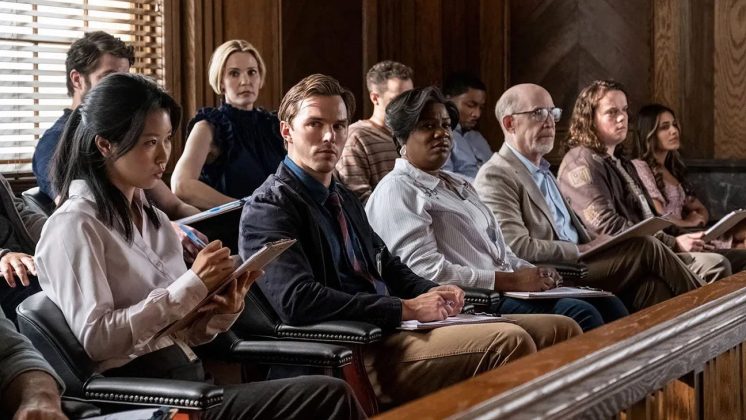
6. Juror #2, 2024
Unbelievable, but a fact!
For now, the last film directed by a true Hollywood legend, Clint Eastwood, and not starring him, will not be able to compete for the Oscars, because Warner Bros. executives have done their best to make sure that it doesn’t.
“Our studio is not a friends’ show, it’s show business”, said David Zaslav, the new head of the corporation, a couple of years ago, when he joined the two merged film studios WarnerMedia and Discovery, Inc. at the helm of the new Discovery and Entertainment Alliance.
This, according to the Wall Street Journal, was his reaction to the news that Clint Eastwood’s drama Cry Macho (2021), which cost $33 million to make, had earned only half that on screens worldwide.
It is no fun to remind the newly minted boss (who in America is already nicknamed the ‘notorious enemy of cinema’) that over five decades, it is the Warner Bros. films made by Mr Eastwood that have made billions of dollars.
Not to mention the fact that Eastwood is one of the most disciplined film directors in Hollywood, always staying within the studio’s budget and winning four Oscars.
It is therefore, according to Variety, “despicable and disgusting” that the 94-year-old veteran’s latest film, Juror #2, will not even be nominated for an Oscar when it opens at the American Film Festival.
As part of this strategy, the film will only be shown on a few major screens (four in New York, five in the Los Angeles area and one in Chicago), which, according to one studio source, must be seen as a “gesture of gratitude”.
This was immediately slammed by the influential Variety critic J. Kim Murphy, who wrote that even though Warner might lose money by showing Eastwood’s film more widely, “it would be a pittance compared to the hundreds of millions that studio executives have just thrown away by giving Todd Phillips $200 million for Joker: Folie à Deux, which was a complete fiasco.
Juror No. 2” tells the truly intriguing story of how one juror (played by Nicholas Hoult, who is currently being actively filmed), Justin Kemp, is faced with a serious moral dilemma as a juror in a high-profile murder trial: he knows something that could be used to help the jury reach a verdict that will either convict or free a potential murderer.
Initially, Kemp tries to escape his burden because he has a good reason: his wife is about to give birth. But his appeal to patriotic duty and his impeccable reputation (no criminal record, etc.) gets him a seat in the courtroom as Juror No 2.
From the very first meetings, it becomes clear where the film’s legs are “sprouting” from. Simply put, the plot’s outline and further development are reminiscent of the classic courtroom drama “Twelve Angry Men” (12 Angry Men, 1957, dir. S. Lumet), in which twelve jurors locked in a separate room decided whether a Mexican boy who allegedly killed his father was really guilty. The case seemed elementary, the key evidence was against the guy, so the eleven jurors hastily voted in favour, but this solidarity was soon shattered by Juror 8 (played by Henry Fonda), who suggested that all the evidence should be considered in full. In the end, the guy was acquitted.
At the beginning of Eastwood’s film, eleven randomly selected jurors think that the case is simple and that there is no time to waste. But Nicholas Hoult’s character dares to challenge this monolithic position. Perhaps he would have been better off not doing so?
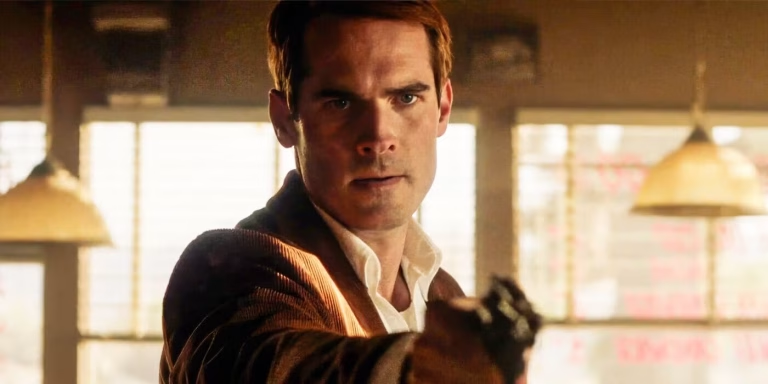
5. The Last Stop in Yuma County, 2024
Those who miss the style of Quentin Tarantino’s first films should enjoy “Last Stop in Yuma County”. It has the playful dialogue “a la Tarantino”, the twisted crime plot and the retro style of Quentin’s first films (set in 1970s America).
The low-budget film, directed by Francis Galluppi, did not earn much (around 100 000 dollars), but as an independent film project, these are good figures. Especially as they are confirmed and magnified by three awards at prestigious independent film festivals (it even won Best Feature Film at the Festival de la Cité de Catalunya).
Justifying the film’s time period, Last Stop… is reminiscent of crime films of the 1970s.
The main character of the film is Jim, a knife-selling salesman. A detail that immediately makes you cringe, like the man’s nickname “The Knife Salesman”: he is played by a little-known actor, Jim Cummings, who is better known to fans of independent cinema as the director of a number of successful films.
The man had long been discouraged by his life on wheels, but he saw no way out of the cursed cycle of stagnation. Until fate brought him to a heat-stricken town in Arizona. Here, before his feet are even warm, Jim finds himself hostage to criminals who have just robbed a bank.
With every cop in the county hot on his heels, Jim realises that his life hangs in the balance. How will the thugs treat him when they corner him?
This is a thought that haunts not only Jim himself, but also the audience watching the film unfold.
The encounter between Jim and the bandits is portrayed in a truly Tarantino-esque manner. Just after entering the town, the driver stops at a petrol station to fill up his empty tank, only to find that the station is empty and he has to wait for the petrol truck. The same is true for the bandits, whose robbery, green Ford Pinto and the loot of seven hundred thousand dollars are already being reported on the radio news. Both Jim and the bandits have no choice, as the next nearest petrol station is 150 miles away.
While waiting for the petrol truck, more people show up at the scene: the sheriff brings his wife Charlotte, who works at a café near the petrol station, an elderly Indian and two married couples. The tension builds up, as if you could feel a ticking time bomb. Because not everyone trapped in a café realises that they are in the same room with criminals who are determined to do anything.
A very characterful bandit was played by the bright-looking actor Richard Brake (we have seen several of his charismatic “bad guys”, and he played the paralysed father of the girl Vesper, Darius, in the Lithuanian director Kristina Buožytė’s fictional film Vesper (2022)). Here, the actor’s suspicious and cunning bandit Bo is the devil incarnate, who is better off staying out of the way.
Against the backdrop of this hell-hole, his accomplice Trevis (Nicholas Logan) seems like an entirely sympathetic character. If Bo is the mastermind and coordinator of the criminal operation, Trevis is the classic “torpedo”, or, more simply, the enforcer. Only his smile often betrays the dark nature behind it.
The other characters in the film, regardless of their importance, also received more attention. This is testimony to the good work of the scriptwriters.
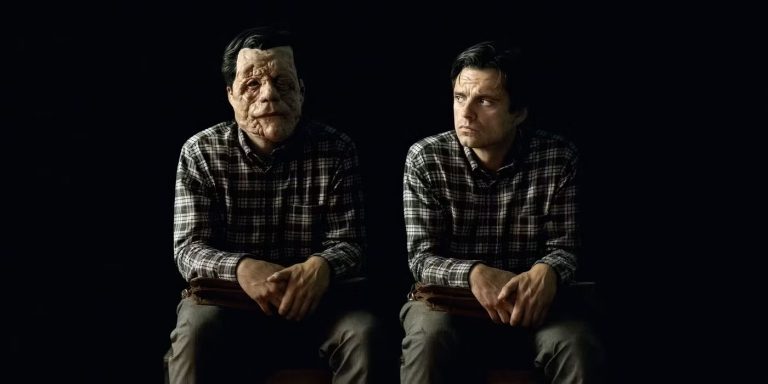
4. A Different Man, 2024
Plastic surgery in cinema has long been a thing of the past. This is a way for people (usually the fairer sex) to try to prolong their youth as long as possible. In crime films, we see much more complex motivations. Often it is criminals who resort to appearance alteration procedures to avoid the responsibility of their heinous jobs, and who are so eager to start a new life.
French director Jacques Audiard’s Emilia Perez, which is coming to the big screen, shows the exotic-looking result of plastic surgery, where a sinister Mexican drug cartel boss is transformed into a glamorous girl because he has felt like a woman in a man’s body all his life.
The metamorphosis into another man is also shown by US director Aaron Schimberg in “Another Man”, while the lead actor Sebastian Stan was awarded for his courage and sacrifice at the Berlin International Film Festival.
In the seductive world of movie stars, the issue of plastic rejuvenation is a very topical one. Only the results are not always what wealthy clients expect for big money. The motivation in such cases is the same – to stay in the film business as long as possible.
This motivation also drives Edward Lemuel, the New York actor and protagonist of “The Other Man”, whose facial features have been mercilessly disfigured by neurofibromatosis, to seek plastic surgery.
Edward also suffers from the fact that he is still considered a loser actor who is only offered small supporting roles. This status has even led to him being called a Woody Allen-type neurotic (by the way, the cinematographer Wyatt Garfield actually often shoots the images as if he were working with Allen in the 1970s).
So, in order to fix his unpromising career and finally get the role he wants, Edward decides to literally rip off the skin of his face (a similarly gruesome scene could grace a David Cronenberg body-horror film that loves such nightmares) and gets a new face. And with it, a new identity. He becomes a successful real estate agent, calls himself Guy Morac and announces that Edward has committed suicide.
Now, in his new guise, he is reacquainted with his former neighbour Ingrida Vold, who used to ignore him because of his appearance. But she has used the experience to write a play about a man with a deformed face, and the play is about to be produced on Broadway. And Gaius gets the lead role…
The director spends a great deal of time and suddenly jumps to a new period in the life of Edward-Gaius, without going into the circumstances that made the loser a successful businessman.
But the man has not completely escaped his old identity. He has kept the old face mask given to him by his doctor, which Edward-Guy sometimes uses in very exotic circumstances.
It is very difficult to believe in the reality of the situations depicted in the film. But if we think of it as a metaphorical story, everything becomes much more understandable.
And it is precisely this attitude that helps to give the famous “Substance” a completely different dimension.
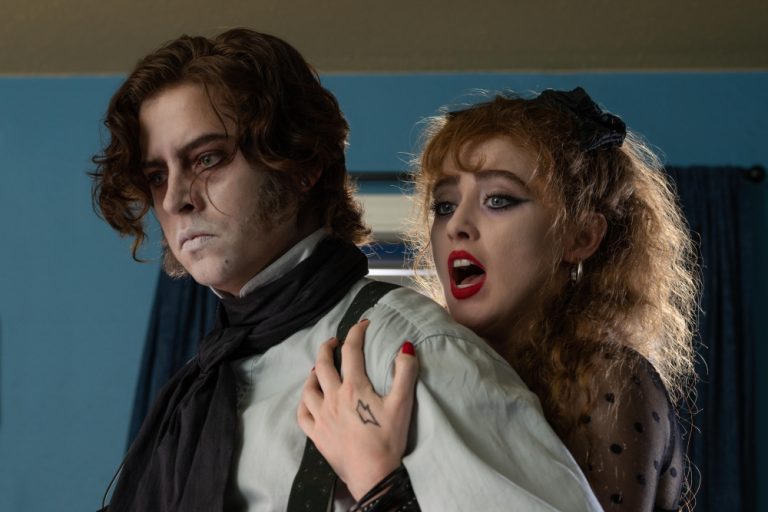
3. Lisa Frankenstein, 2024
As the years go by, it is becoming increasingly clear that almost every year we are doomed to watch new screen adaptations of two undead gothic horror novels. For both Mary Shelley, who wrote Frankenstein in 1818, and Bram Stoker, who invented the vampire Dracula at the end of the 19th century, invented the perpetual-motion machine that will power cinema for a long time.
In the first week of the year, we saw the release of Nosferatu (directed by Robert Eggers), which has been dubbed the year’s creepiest thriller even before its premiere. Inspired by gothic horror stories, the film draws on two sources: Bram Stoker’s late 19th century novel Dracula and the 1922 German expressionist masterpiece Nosferatu – A Symphony of Terror.
This year will also see the Mexican filmmaker Guillermo del Toro’s Frankenstein, hailed as a cinematic visionary, which promises to be a far cry from the literary original.
Last year’s Liza Frankenstein (directed by Zelda Williams) showed that it is not even possible to stray far from Mary Shelley’s literary masterpiece. In this film, which the authors have called a romantic horror comedy, there is nothing left of the book about New Prometheus except the name of the monster.
This radical operation on a classic plot was carried out by screenwriter Diablo Cody (a pseudonym chosen by the young American Brook Busey), who swept away all traditional obstacles like a hurricane with her first, thuggish screenplay for Juno (2007, dir. Jason Reitman), which earned her a reputation as a bold innovator, and even an Oscar for her original screenplay.
“Lisa Frankenstein is also a very original interpretation of a classic storyline, but it is not really worth calling it a great value. Rather, it is a jumble of girlish dreams.
The film’s teenage protagonist, Liza Svolous (Kathryn Newton), is still unable to forget the tragedy of her mother’s murder by a maniac with an axe two years ago. The girl’s father is married to another woman who has a daughter from a previous marriage.
Suffering from loneliness, Lisa spends most of her time in the local cemetery. She is particularly fond of the grave of a young man who died in 1837: a young pianist who couldn’t bear to part with the woman he loved.
One day, the most incredible thing happens here: the grave is struck by lightning, and the romantic dead man is reborn as a zombie. The creature is mute and lacks several body parts. But that doesn’t stop him from playing the piano…
What follows is a series of macabre scenes that could only have been created in the imagination of people who have completely “detached” themselves from reality.
When the launch of “Liza Frankenstein” was announced, the press was full of optimism and anticipation for an original interpretation of a story everyone knows by heart. The optimists recalled the horror-comedy Jennifer’s Body (2009, dir. Karyn Kusama), based on a screenplay by Diablo Cody, in which a graduate is possessed by a malevolent demon and starts to have strange attractions to boys. Now they attract her not as candidates for dates or fun times, but as food!
If the story of this film were taken seriously, it would be another silly Hollywood spectacle. Unlike the romantic thrillers of the Twilight series, the authors of Jennifer’s Body have made no secret of the fact that they are not going to bore the audience with the romance of adolescence, nor with pseudo-philosophical allegories. The filmmakers did not even try to scare the audience, but instead encouraged smiles and laughter.
Jennifer’s Body was not scary at all. But “Liza Frankenstein” is often embarrassing.
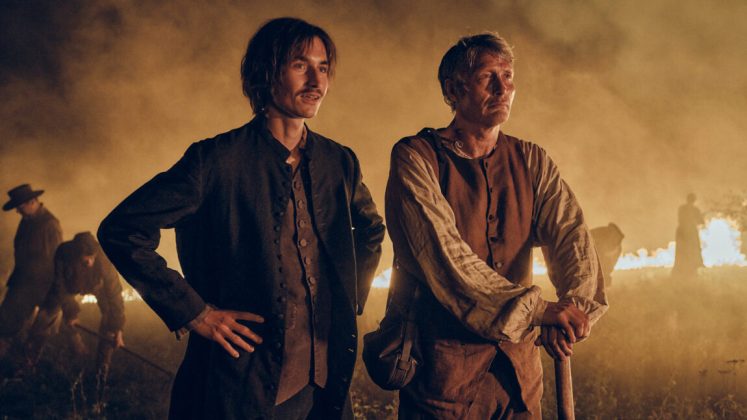
The original title of the film “Basterden” means “basterd” or “benkart”.
This is the name given to Captain Ludvig Kalen, played by Mads Mikkelsen, the illegitimate son of a bastard and a maid, who decides to conquer the harsh territories of the Jutland peninsula in order to achieve the seemingly impossible goal of establishing a colony on behalf of the king.
As the guardians of the royal treasury laugh at these plans and do not offer any financial help, Kalen offers to pay for this adventure from his soldier’s pension.
In return, he wants to receive the title of a nobleman, but the arrogant and ruthless ruler of these territories, the District Judge Frederic de Shinkel, is not prepared to give up his lands without a fight. When Schinkel discovers that his maid Anna Barbara and her husband are attempting to take refuge in the Society of Cullen, the vengeful lord vows to expel the master from his domain at any cost.
With only a horse, a tent and a pistol to protect himself from the bandits, and a few tools to dig the hard ground, Ludwig sets up camp. Eventually, he finds land that, when mixed with clay from the seaside, can produce a crop of potatoes brought back from Germany.
“The Bastard is an epic Nordic western of cinematic beauty.
It is set in mid-18th century Denmark. The film is based on Ide Jessen’s historical novel ‘The Captain and Anna Barbara’.
This is the second collaboration between Mads Mikkelsen and director Nikolaj Arcel. The first one was also screened at Scanorama. “In The Royal Novel (2012), also set in 18th-century Denmark, then ruled by King Christian VII, who was thought to be insane. There, Mads Mikkelsen played Johann Strunze, a German doctor who falls in love with the young Queen.

1. Parthenope, 2024
The distributors present the film as follows:
“Parthenope is a woman who has a name for her city. Is she a siren or a myth?
Just after she was born, the girl was named by her dad, the former mayor of Naples, after a siren turned into a magnificent city. The divine Parthenope (played by the actress and model Celeste Dalla Porta in her youth and by the actress Stefania Sandrelli in her mature years) is destined to embody the irresistible, maddening, vital passionate charm of youth. She is like a mirage, a memory of the joys or tragedies she once experienced. Parthenope is a living reflection of an irretrievable past in a city whose graceful silhouette and indescribable beauty are most evident when seen from the luxurious villa on the island of Capri.
Paolo Sorrentino, this time in collaboration with the Yves Saint Laurent fashion house, creates a highly stylish and glossy spectacle. The camera and the characters, when placed in the same space as Parthenope, cannot take their eyes off her (excellent performances by Gary Oldman, Silvio Orlando). The world is looking at her, and she, who has chosen the path of an anthropologist, is exploring the world. As Sorrentino follows Parthenope’s life over several decades, audiences will recognise motifs from the director’s earlier films in this surreal and touchingly sentimental dream.
This latest film by Italian director Paolo Sorrentino is hailed by some as a magnificent masterpiece, and by others as yet another imitation of Fellini’s style.
Our online space is full of emotional reviews of the film, which is something that doesn’t happen very often. The last time, as far as I can remember, there was such a tumultuous and controversial reaction to the now successfully forgotten Swedish director Ruben Östlund’s The Triangle of Sadness (2022).




